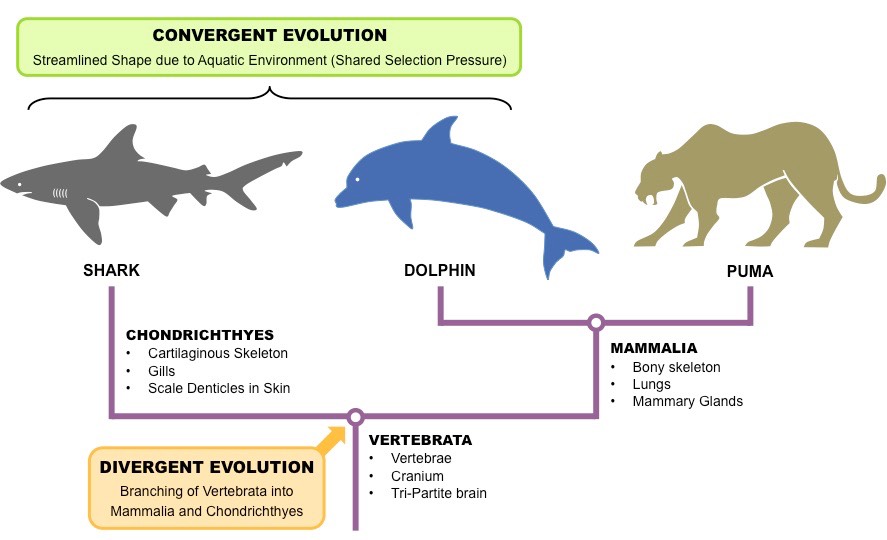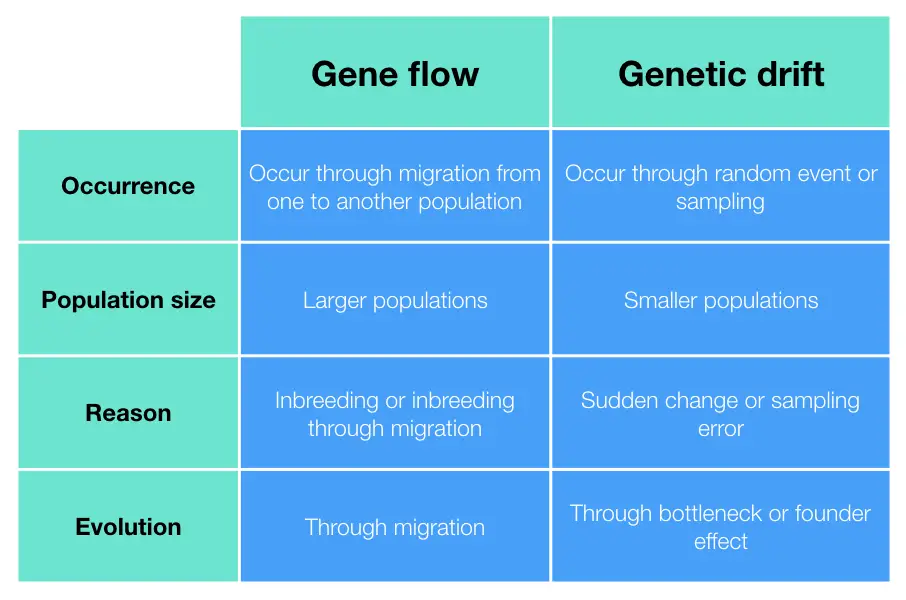AP Bio: Unit 7 - Natural Selection
1/16
There's no tags or description
Looks like no tags are added yet.
Name | Mastery | Learn | Test | Matching | Spaced |
|---|
No study sessions yet.
17 Terms
How does natural selection drive evolution? (Topic 1)
According to Darwin’s theory of natural selection, it leads to the passing of favorable phenotypes to subsequent generations through differential survival
Evolutionary fitness = reproductive success (offspring that is fertile)
How can the rate and direction of evolution be affected? (Topic 1)
Biotic/abiotic environments can fluctuate in stability which can lead to different traits being selected for each generation
Natural selection depends on phenotypic variation in populations
Some phenotypic variations can decrease or increase fitness of organism are specific environments
Artifical selection by humans can affect variation
What is convergent evolution? (Topic 1)
It is when similar pressures result in similar phenotypic adaptations in different populations or species

How can evolution be driven by random occurences? (Topic 2)
Mutation → genetic variation
Genetic drift - change in frequency of an existing gene in a small populaton due to random chance → Less genetic diversity
Bottleneck effect - reduction in population size
Founder effect - small group migrates and establishes new population
Gene flow - Movement of genes across large populations due to migration/inbreeding → More genetic diversity

What happens if there’s a decrease in genetic variation? (Topic 2)
It can increase the differences between populations of the same species because it reduces a populations ability to adapt to different environmental pressures
can lead to divergence through natural selection and genetic drift (think Galapagos finches)
What is Hardy-Weinberg, and what conditions need to be met in order to reach Hardy-Weinberg equilibrium? (Topic 2)
Hardy-Weinberg is a model for describing and predicting allele frequencies in a nonevolving population.
Hardy-Weinberg equilibrium must be met through
A large population size
absense of migration
no mutations
random mating
absense of selection
Frequence can be calculation using p² + 2pq + q² = 1
p² = Frequency of homozygous dominant genotype
2pq = Frequency of heterozygous genotype
q² = Frequency of homozygous recessive genotype
or p + q = 1
p = frequency of one allele
q = frequency of the other allele
How do population relate to evolution? (Topic 2)
Small populations are more susceptible to random environmental impact compared to bigger ones.
Genetic diversity can help populations become more resilient to environmental impact.
Where can evidence for evolution be drawn from? (Topic 3)
Evidence can be drawn from many different disciplines such as geographical, geological, physical, biochemical, and mathematical data
Fossil dating using the age of the rocks, the rate od decay of isotopes w/ carbon-14, or geographical data
Similar structures, like vestigial structures, that can point to common ancestry
DNA nucleotide/protein amino acid sequences
Shared fundamental molecular and cellular features
What structural evidences point to common ancestry of all eukaryotes? (Topic 3)
Membrane-bound organelles
Linear chromosomes
Genes w/ introns
How do species continue to evolve over time? (Topic 3)
Genomic changes (mutations)
continuous change in fossil record
reistance to antibiotics, pesticides, herbicides, chemotherapy drugs
exposure to pathogens
How do phylogenetic trees and cladograms map out evolution? (Topic 3)
Both:
Show relationships between lineages
Contain traits that were gained or lost durign evolution
Contain shared character that are present in more than one lineage
Out-represents lineage least related to the rest of the organisms
Can illustrate speciation
Can be created using morphological similarites or DNA and protein sequence similarities
Represent hypotheses that are constant being revised
Phylogenetic trees:
Show change over time by fossils or molecular clock
Molecular data can provide more accurate evidence compared to morphological traits
What is speciation, and when does it happen? (Topic 4)
Speciation is when new species form over time
Occurs when two populations become isolated in some way
Temporal isolation, reproductive isolation, behavior isolation, habitat isolation, gametic isolation (postzygotic), prezygotic isolation, mechanical isolation,
Results in diversty of life forms
Can be sympatric (taking place without geographical separation) or allopatric (taking place with geographical separation)
What is a species? (Topic 4)
A species can be defined sexually reproducing organisms that are capable of interbreeding adn exchanging genetic information to produce viable, fertile offspring
What is punctuated equilibrium and gradualism? (Topic 4)
Punctuated equilibrium is when evolutation occurs rapidly after a long period of stasis (no evolution).
Gradualism is when evolution happens slowly over centuries or more.
What is divergent evolution? (Topic 4)
It is when adaptation to new habitats leds to phenotypic diversification
Speciation rates can be rapid during adaptive radiation (the process by which a single species rapidly diversifies into multiple species that exploit different niches) once new habitats become available
How are extinctions relevant? (Topic 4)
They have occured throughout Earth’s history.
Can be rapid during ecological stress
Human activity can cause changes to environment that can lead to extinction
Can lead to greater diversity in an ecosystem due to resulting in new niches that can be exploited by other species
What are some hypothesis about the origin of life on Earth and their scientific evidence? (Topic 5)
Geological evidences supports model of origin of life on Earth
Earth formed ~4.6bya and had harsh environments until 3.9 bya, and the earliest fossil dates back to 3.5bya showing a range in which life could’ve occured
Several models about the origin of life include
There were inorganic precursors that could have synthesized organic molecules due to the presence of free energy and the significant absense of atmospheric oxygen (O2) (Miller-Urey experiment)
Organic molecules could’ve come from meteorites or other celestial events
Chemical experiments have shown it is possible to create complex organic molecules from inorganic molecules in spite of the absense of life
Organic molecules/monomers are building blocks for complex organic molecules/polymers (amino acids, nucleotides)
Monomers + monomers = polymers that can replicate, store, transform info
RNA world hypothesis - RNA, not DNA or proteins, was the primary molecule that stored genetic info and catalyzed chemical reaction in early Earth, making it the earliest genetic material